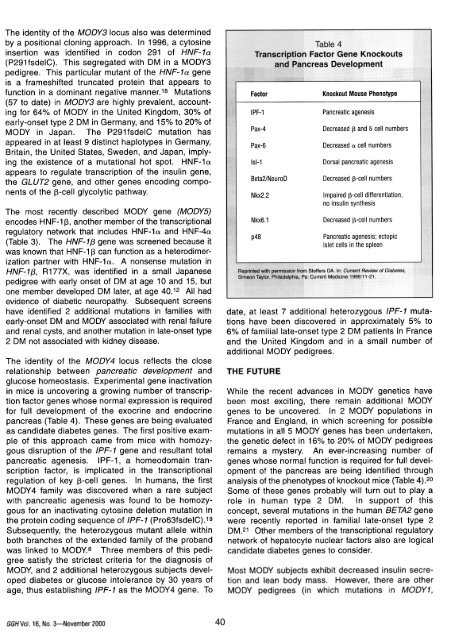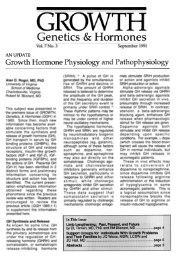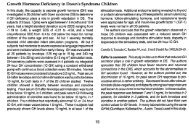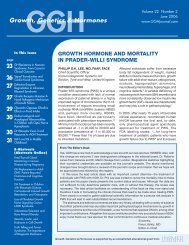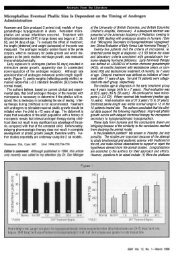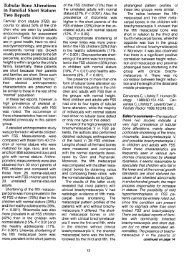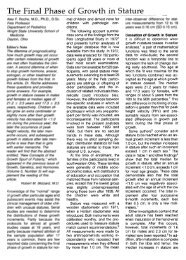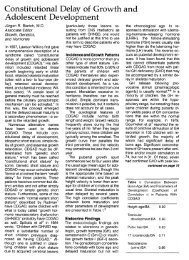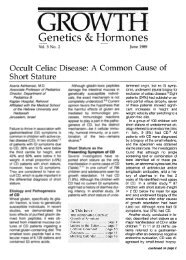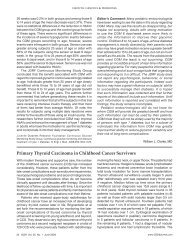maturity-onset diabetes of the young (mody) - GGH Journal
maturity-onset diabetes of the young (mody) - GGH Journal
maturity-onset diabetes of the young (mody) - GGH Journal
You also want an ePaper? Increase the reach of your titles
YUMPU automatically turns print PDFs into web optimized ePapers that Google loves.
The identity <strong>of</strong> <strong>the</strong> MODY3 locus also was determined<br />
by a positional cloning approach. In 1996, a cytosine<br />
insertion was identified in codon 291 <strong>of</strong> HNF-1a<br />
(P291fsdeIC). This segregated with OM in a MOOY3<br />
pedigree. This particular mutant <strong>of</strong> <strong>the</strong> HNF-1a gene<br />
is a frameshifted truncated protein that appears to<br />
function in a dominant negative manner.18 Mutations<br />
(57 to date) in MODY3 are highly prevalent, accounting<br />
for 64% <strong>of</strong> MOOY in <strong>the</strong> United Kingdom, 30% <strong>of</strong><br />
early-<strong>onset</strong> type 2 OM in Germany, and 15% to 20% <strong>of</strong><br />
MOOY in Japan. The P291fsdeiC mutation has<br />
appeared in at least 9 distinct haplotypes in Germany,<br />
Britain, <strong>the</strong> United States, Sweden, and Japan, implying<br />
<strong>the</strong> existence <strong>of</strong> a mutational hot spot. HNF-1a<br />
appears to regulate transcription <strong>of</strong> <strong>the</strong> insulin gene,<br />
<strong>the</strong> GLUT2 gene, and o<strong>the</strong>r genes encoding components<br />
<strong>of</strong> <strong>the</strong> r3-cell glycolytic pathway.<br />
The most recently described MOOY gene (MODY5)<br />
encodes HNF-1[3, ano<strong>the</strong>r member <strong>of</strong> <strong>the</strong> transcriptional<br />
regulatory network that includes HNF-1a and HNF-4a<br />
(Table 3). The HNF-1f3 gene was screened because it<br />
was known that HNF-1[3 can function as a heterodimerization<br />
partner with HNF-1a. A nonsense mutation in<br />
HNF-1f3, R177X, was identified in a small Japanese<br />
pedigree with early <strong>onset</strong> <strong>of</strong> OM at age 10 and 15, but<br />
one member developed OM later, at age 40.12 All had<br />
evidence <strong>of</strong> diabetic neuropathy. Subsequent screens<br />
have identified 2 additional mutations in families with<br />
early-<strong>onset</strong> OM and MOOY associated with renal failure<br />
and renal cysts, and ano<strong>the</strong>r mutation in late-<strong>onset</strong> type<br />
2 OM not associated with kidney disease.<br />
The identity <strong>of</strong> <strong>the</strong> MOOY 4 locus reflects <strong>the</strong> close<br />
relationship between pancreatic development and<br />
glucose homeostasis. Experimental gene inactivation<br />
in mice is uncovering a growing number <strong>of</strong> transcription<br />
factor genes whose normal expression is required<br />
for full development <strong>of</strong> <strong>the</strong> exocrine and endocrine<br />
pancreas (Table 4). These genes are being evaluated<br />
as candidate <strong>diabetes</strong> genes. The first positive example<br />
<strong>of</strong> this approach came from mice with homozygous<br />
disruption <strong>of</strong> <strong>the</strong> IPF-1 gene and resultant total<br />
pancreatic agenesis. IPF-1, a homeodomain transcription<br />
factor, is implicated in <strong>the</strong> transcriptional<br />
regulation <strong>of</strong> key ~-cell genes. In humans, <strong>the</strong> first<br />
MODY 4 family was discovered when a rare subject<br />
with pancreatic agenesis was found to be homozygous<br />
for an inactivating cytosine deletion mutation in<br />
<strong>the</strong> protein coding sequence <strong>of</strong> IPF-1 (Pro63fsdeIC).19<br />
Subsequently, <strong>the</strong> heterozygous mutant allele within<br />
both branches <strong>of</strong> <strong>the</strong> extended family <strong>of</strong> <strong>the</strong> proband<br />
was linked to MODY.8 Three members <strong>of</strong> this pedigree<br />
satisfy <strong>the</strong> strictest criteria for <strong>the</strong> diagnosis <strong>of</strong><br />
MODY, and 2 additional heterozygous subjects developed<br />
<strong>diabetes</strong> or glucose intolerance by 30 years <strong>of</strong><br />
age, thus establishing IPF-1 as <strong>the</strong> MODY 4 gene. To<br />
date, at least 7 additional heterozygous IPF-1 mutations<br />
have been discovered in approximately 5% to<br />
6% <strong>of</strong> familial late-<strong>onset</strong> type 2 OM patients in France<br />
and <strong>the</strong> United Kingdom and in a small number <strong>of</strong><br />
additional MOOY pedigrees.<br />
THE FUTURE<br />
While <strong>the</strong> recent advances in MODY genetics have<br />
been most exciting, <strong>the</strong>re remain additional MODY<br />
genes to be uncovered. In 2 MODY populations in<br />
France and England, in which screening for possible<br />
mutations in all 5 MODY genes has been undertaken,<br />
<strong>the</strong> genetic defect in 16% to 20% <strong>of</strong> MODY pedigrees<br />
remains a mystery. An ever-increasing number <strong>of</strong><br />
genes whose normal function is required for full development<br />
<strong>of</strong> <strong>the</strong> pancreas are being identified through<br />
analysis <strong>of</strong> <strong>the</strong> phenotypes <strong>of</strong> knockout mice (Table 4).20<br />
Some <strong>of</strong> <strong>the</strong>se genes probably will turn out to playa<br />
role in human type 2 DM. In support <strong>of</strong> this<br />
concept, several mutations in <strong>the</strong> human BETA2 gene<br />
were recently reported in familial late-<strong>onset</strong> type 2<br />
DM.21 O<strong>the</strong>r members <strong>of</strong> <strong>the</strong> transcriptional regulatory<br />
network <strong>of</strong> hepatocyte nuclear factors also are logical<br />
candidate <strong>diabetes</strong> genes to consider.<br />
Most MODY subjects exhibit decreased insulin secretion<br />
and lean body mass. However, <strong>the</strong>re are o<strong>the</strong>r<br />
MODY pedigrees (in which mutations in MODY1,<br />
<strong>GGH</strong>Vol. 16, No.3-November 2000<br />
40


